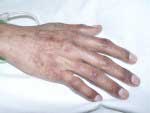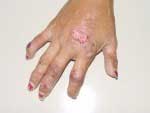The term porphyria refers to a group of diseases in which, as a result of a metabolic defect, there is an overproduction of substances known as porphyrins. In most cases the defect is genetic, and a mutation carried within a family results in a faulty enzyme which cannot handle the normal metabolism of porphyrins, with a consequent overproduction. One form of porphyria (porphyria cutanea tarda), is however usually not genetic, but is acquired or "picked up" as a result of certain forms of liver dysfunction. In this case, the defect is found only in the patient and not in his or her family.
Symptoms
In general, patients with porphyria have only two major symptoms: the acute attack and skin photosensitivity. It is important to realise that not every porphyria is associated with both problems, and you should be sure in your own mind of which type of porphyria you have and what its possible effects are. The types of porphyria and their effects are outlined below
The acute attack is a serious condition which arises during a time of particularly active porphyrin overproduction, and may follow exposure to a wide range of drugs and medications which stimulate the production of porphyrins. It is felt by the patient as an attack of severe abdominal pain, possibly with nausea, vomiting, constipation and pain in the limbs and back. It may potentially deteriorate into a state of paralysis, and is therefore dangerous. Fortunately however, there is very effective treatment available which will prevent this provided the attack is recognised and treated early.
The skin disease takes the form of easy blistering and development of sores, scabs and scars in sun-exposed areas, particularly the backs of the hands and face.
Types of Porphyria
There are seven types of porphyria, each differing slightly according to the specific enzyme which is defective. The clincial symptoms overlap however. Acute intermittent porphyria (AIP) and ALA dehydratase deficiency (Doss) porphyria are associated with acute attacks only, but no skin disease. porphyria cutanea tarda (PCT) , erythropoietic protoporphyria (EPP) and congenital erythropoietic porphyria (CEP) are associated only with skin disease, but not with acute attacks. Variegate porphyria (VP) and hereditary coproporphyria (HCP) are associated with both. Variegate porphyria is common in South Africa, The other forms of porphyria are also encountered in South Africa, but less frequently.
Further Information
You will find more information on each of these porphyrias by clicking the entry for each on the menu. Read our handbook for patients as well as the many reference pages available on this site. Further information about any aspect of porphyria can be obtained from our Porphyria Information Centre.

